Correlation Analysis of Large-Span Cable-Stayed Bridge Structural Frequencies with Environmental Factors Based on Support Vector Regression
Abstract
:1. Introduction
2. Hardware, Equipment, and Methods
2.1. Bridge Monitoring System Description
2.2. Automated Covariance-Driven Stochastic Subspace Identification Method (SSI-COV) with the Clustering Algorithm
3. Identification Results
3.1. Subsection
3.2. Correlation Research between Temperature, Humidity and Frequency
4. Temperature-Frequency Nonlinear Model Analysis
4.1. Nonlinear Model Based on SVR Regression Analysis
4.2. Model Quality Analysis
4.3. Eliminate Temperature Effects
5. Discussion and Conclusions
- Linear regression was used to observe the relationship between identified frequencies and environmental temperature. The results indicated a significant negative correlation between the bridge’s frequency and environmental temperature, while humidity showed no significant correlation with modal frequencies.
- A nonlinear Support Vector Machine (SVM) model was employed for fitting and modeling. Residual analysis of the model revealed a clear linear relationship between frequency and temperature. The SVM model effectively fit the sample data and provided reliable predictive results.
- After obtaining temperature-induced frequency data from the SVR model, the original structural frequencies were smoothed, and temperature influences were eliminated. It was observed that, after eliminating temperature effects, the frequency fluctuations with a 24 h period significantly decreased.
Author Contributions
Funding
Institutional Review Board Statement
Informed Consent Statement
Data Availability Statement
Acknowledgments
Conflicts of Interest
References
- Chu, X.; Cui, W.; Xu, S.; Zhao, L.; Guan, H.; Ge, Y. Multiscale Time Series Decomposition for Structural Dynamic Properties: Long-Term Trend and Ambient Interference. Struct. Control Health Monit. 2023, 2023, 6485040. [Google Scholar] [CrossRef]
- Wang, Z.; Yang, D.H.; Yi, T.H.; Zhang, G.-H.; Han, J.-G. Eliminating Environmental and Operational Effects on Structural Modal Frequency: A Comprehensive Review. Struct. Control Health Monit. 2022, 29, e3073. [Google Scholar] [CrossRef]
- Sun, L.; Shang, Z.; Xia, Y.; Bhowmick, S.; Nagarajaiah, S. Review of Bridge Structural Health Monitoring Aided by Big Data and Artificial Intelligence: From Condition Assessment to Damage Detection. J. Struct. Eng. 2020, 146, 04020073. [Google Scholar] [CrossRef]
- Wang, X.; Gao, Q.; Liu, Y. Damage Detection of Bridges under Environmental Temperature Changes Using a Hybrid Method. Sensors 2020, 20, 3999. [Google Scholar] [CrossRef] [PubMed]
- Locke, W.; Sybrandt, J.; Redmond, L.; Safro, I.; Atamturktur, S. Using Drive-by Health Monitoring to Detect Bridge Damage Considering Environmental and Operational Effects. J. Sound Vib. 2020, 468, 115088. [Google Scholar] [CrossRef]
- Li, H.; Li, S.; Ou, J.; Li, H. Modal Identification of Bridges under Varying Environmental Conditions: Temperature and Wind Effects. Struct. Control Health Monit. 2010, 17, 495–512. [Google Scholar] [CrossRef]
- Kulprapha, N.; Warnitchai, P. Structural Health Monitoring of Continuous Prestressed Concrete Bridges Using Ambient Thermal Responses. Eng. Struct. 2012, 40, 20–38. [Google Scholar] [CrossRef]
- Teng, J.; Tang, D.-H.; Zhang, X.; Hu, W.-H.; Said, S.; Rohrmann, R.G. Automated Modal Analysis for Tracking Structural Change during Construction and Operation Phases. Sensors 2019, 19, 927. [Google Scholar] [CrossRef]
- Jang, J.; Smyth, A.W. Data-driven Models for Temperature Distribution Effects on Natural Frequencies and Thermal Prestress Modeling. Struct. Control Health Monit. 2020, 27, 2489. [Google Scholar] [CrossRef]
- Ni, Y.C.; Zhang, Q.W.; Liu, J.F. Dynamic Property Evaluation of a Long-Span Cable-Stayed Bridge (Sutong Bridge) by a Bayesian Method. Int. J. Struct. Stab. Dyn. 2019, 19, 1940010. [Google Scholar] [CrossRef]
- Cho, K.; Cho, J.R. Effect of Temperature on the Modal Variability in Short-Span Concrete Bridges. Appl. Sci. 2022, 12, 9757. [Google Scholar] [CrossRef]
- Zhou, Y.; Sun, L. Effects of Environmental and Operational Actions on the Modal Frequency Variations of a Sea-Crossing Bridge: A Periodicity Perspective. Mech. Syst. Signal Process. 2019, 131, 505–523. [Google Scholar] [CrossRef]
- Cai, Y.; Zhang, K.; Ye, Z.; Liu, C.; Lu, K.; Wang, L. Influence of Temperature on the Natural Vibration Characteristics of Simply Supported Reinforced Concrete Beam. Sensors 2021, 21, 4242. [Google Scholar] [CrossRef] [PubMed]
- Anastasopoulos, D.; De Roeck, G.; Reynders, E.P.B. One-Year Operational Modal Analysis of a Steel Bridge from High-Resolution Macrostrain Monitoring: Influence of Temperature vs. Retrofitting. Mech. Syst. Signal Process. 2021, 161, 107951. [Google Scholar] [CrossRef]
- Sun, L.; Zhou, Y.; Min, Z. Experimental Study on the Effect of Temperature on Modal Frequencies of Bridges. Int. J. Struct. Stab. Dyn. 2018, 18, 1850155. [Google Scholar] [CrossRef]
- Mosavi, A.A.; Seracino, R.; Rizkalla, S. Effect of Temperature on Daily Modal Variability of a Steel-Concrete Composite Bridge. J. Bridge Eng. 2012, 17, 979–983. [Google Scholar] [CrossRef]
- Gentile, C.; Saisi, A. Long-Term Dynamic Monitoring of the Historic “San Michele” Iron Bridge (1889). In IABSE Symposium Report; International Association for Bridge and Structural Engineering: Zürich, Switzerland, 2013; Volume 99, pp. 22–37. [Google Scholar]
- Venglár, M.; Lamperová, K. Effect of the Temperature on the Modal Properties of a Steel Railroad Bridge. Slovak J. Civ. Eng. 2021, 29, 1–8. [Google Scholar] [CrossRef]
- Kromanis, R.; Kripakaran, P. Data-driven Approaches for Measurement Interpretation: Analyzing Integrated Thermal and Vehicular Response in Bridge Structural Health Monitoring. Adv. Eng. Inform. 2017, 34, 46–59. [Google Scholar] [CrossRef]
- Deng, Y.; Li, A.; Feng, D. Probabilistic Damage Detection of Long-Span Bridges Using Measured Modal Frequencies and Temperature. Int. J. Struct. Stab. Dyn. 2018, 18, 1850126. [Google Scholar] [CrossRef]
- Mao, J.X.; Wang, H.; Feng, D.M.; Tao, T.-Y.; Zheng, W.-Z. Investigation of Dynamic Properties of Long-Span Cable-Stayed Bridges Based on One-Year Monitoring Data Under Normal Operating Condition. Struct. Control Health Monit. 2018, 25, e2146. [Google Scholar] [CrossRef]
- Ding, Y.; Ye, X.W.; Guo, Y. Data Set from Wind, Temperature, Humidity, and Cable Acceleration Monitoring of the Jiashao Bridge. J. Civ. Struct. Health Monit. 2023, 13, 579–589. [Google Scholar] [CrossRef]
- He, X.; Tan, G.; Chu, W.; Zhang, S.; Wei, X. Reliability Assessment Method for Simply Supported Bridge Based on Structural Health Monitoring of Frequency with Temperature and Humidity Effect Eliminated. Sustainability 2022, 14, 9600. [Google Scholar] [CrossRef]
- He, H.; Wang, W.; Zhang, X. Frequency Modification of Continuous Beam Bridge Based on Co-integration Analysis Considering the Effect of Temperature and Humidity. Struct. Health Monit. 2019, 18, 376–389. [Google Scholar] [CrossRef]
- Mu, H.Q.; Zheng, Z.J.; Wu, X.H.; Su, C. Bayesian Network-Based Modal Frequency–Multiple Environmental Factors Pattern Recognition for the Xinguang Bridge Using Long-Term Monitoring Data. J. Low Freq. Noise Vib. Act. Control 2020, 39, 545–559. [Google Scholar] [CrossRef]
- Meng, Q.; Zhu, J. Fine Temperature Effect Analysis–Based Time-Varying Dynamic Properties Evaluation of Long-Span Suspension Bridges in Natural Environments. J. Bridge Eng. 2018, 23, 04018075. [Google Scholar] [CrossRef]
- Wang, Z.; Yi, T.H.; Yang, D.H.; Li, H.-N.; Liu, H. Multiorder Frequency-Based Integral Performance Warning of Bridges Considering Multiple Environmental Effects. Pract. Period. Struct. Des. Constr. 2023, 28, 04023011. [Google Scholar] [CrossRef]
- Wang, Z.; Yi, T.H.; Yang, D.H.; Li, H.-N.; Liu, H. Eliminating the Bridge Modal Variability Induced by Thermal Effects Using Localized Modeling Method. J. Bridge Eng. 2021, 26, 04021073. [Google Scholar] [CrossRef]
- Magalhães, F.; Cunha, A.; Caetano, E. Online Automatic Identification of the Modal Parameters of a Long Span Arch Bridge. Mech. Syst. Signal Process. 2009, 23, 316–329. [Google Scholar] [CrossRef]
- Lu, Y. Fast Hierarchical Clustering Method—PHA. MATLAB Central File Exchange. 2021. Available online: https://www.mathworks.com/matlabcentral/fileexchange/46134-fast-hierarchical-clustering-method-pha (accessed on 4 February 2021).
- Ogier, E. Hierarchical Clustering. MATLAB Central File Exchange. 2021. Available online: https://www.mathworks.com/matlabcentral/fileexchange/56844-hierarchical-clustering (accessed on 4 February 2021).
- Van Overschee, P.; De Moor, B.L. Subspace Identification for Linear Systems: Theory—Implementation—Applications; Springer Science & Business Media: Berlin/Heidelberg, Germany, 2012. [Google Scholar]
- Van Gestel, T.; De Brabanter, J.; De Moor, B.; Suykens, J.A.K.; Vandewalle, J. Least Squares Support Vector Machines; World Scientific: Singapore, 2002. [Google Scholar]
- Ke-qing, F.A.N.; Yi-qing, N.I.; Zan-ming, G.A.O. Research on Temperature Influences in Long-Span Bridge Eigenfrequencies Identification. China J. Highw. Transp. 2006, 19, 67. [Google Scholar]
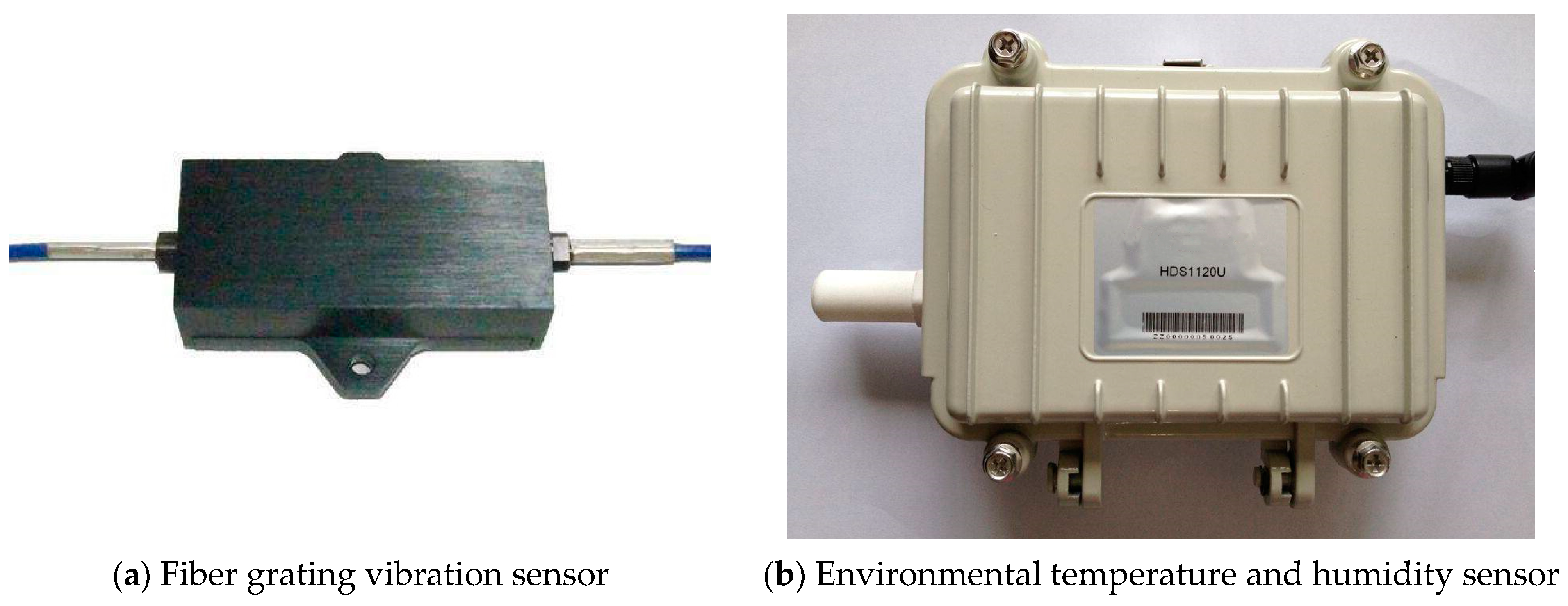

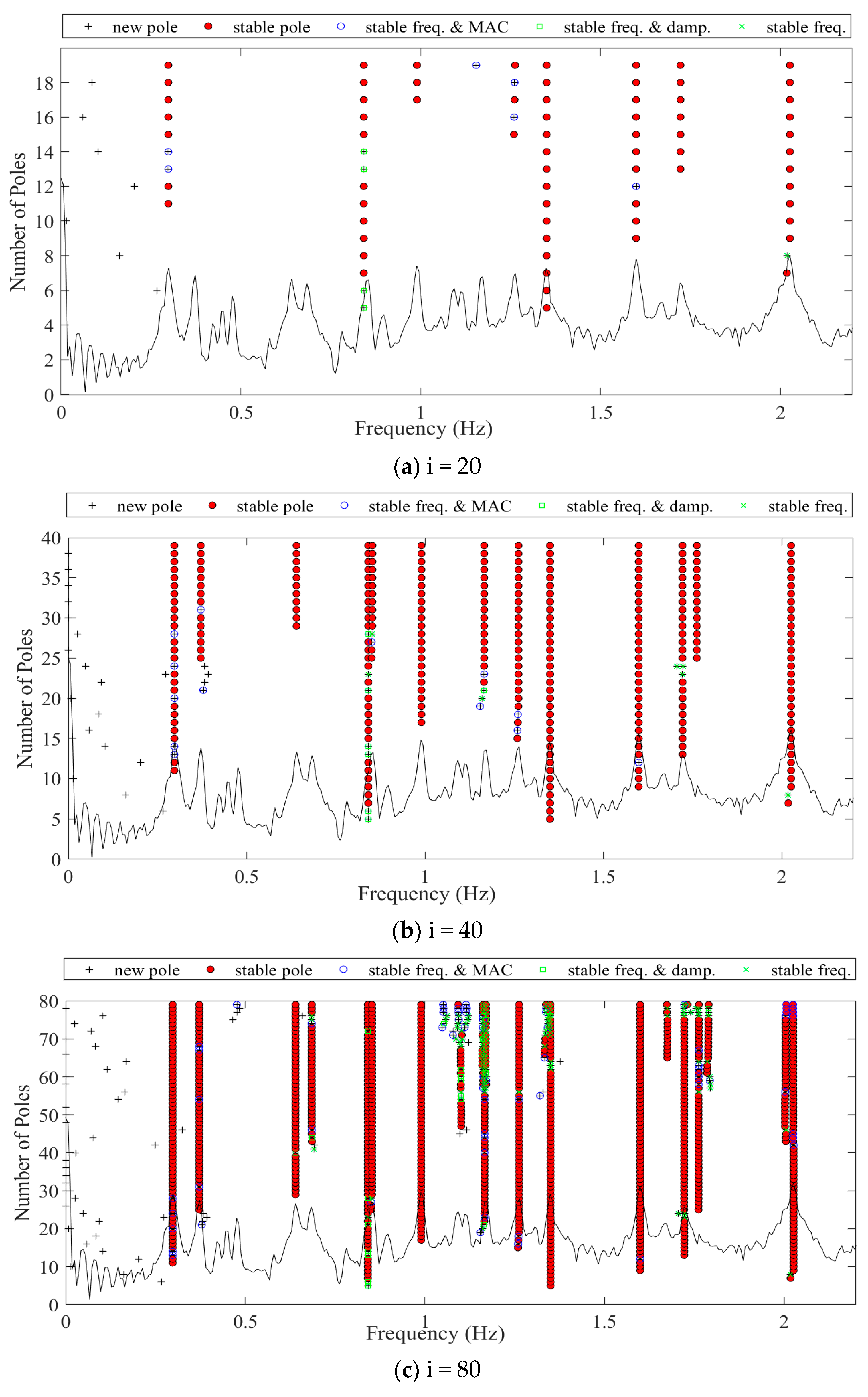

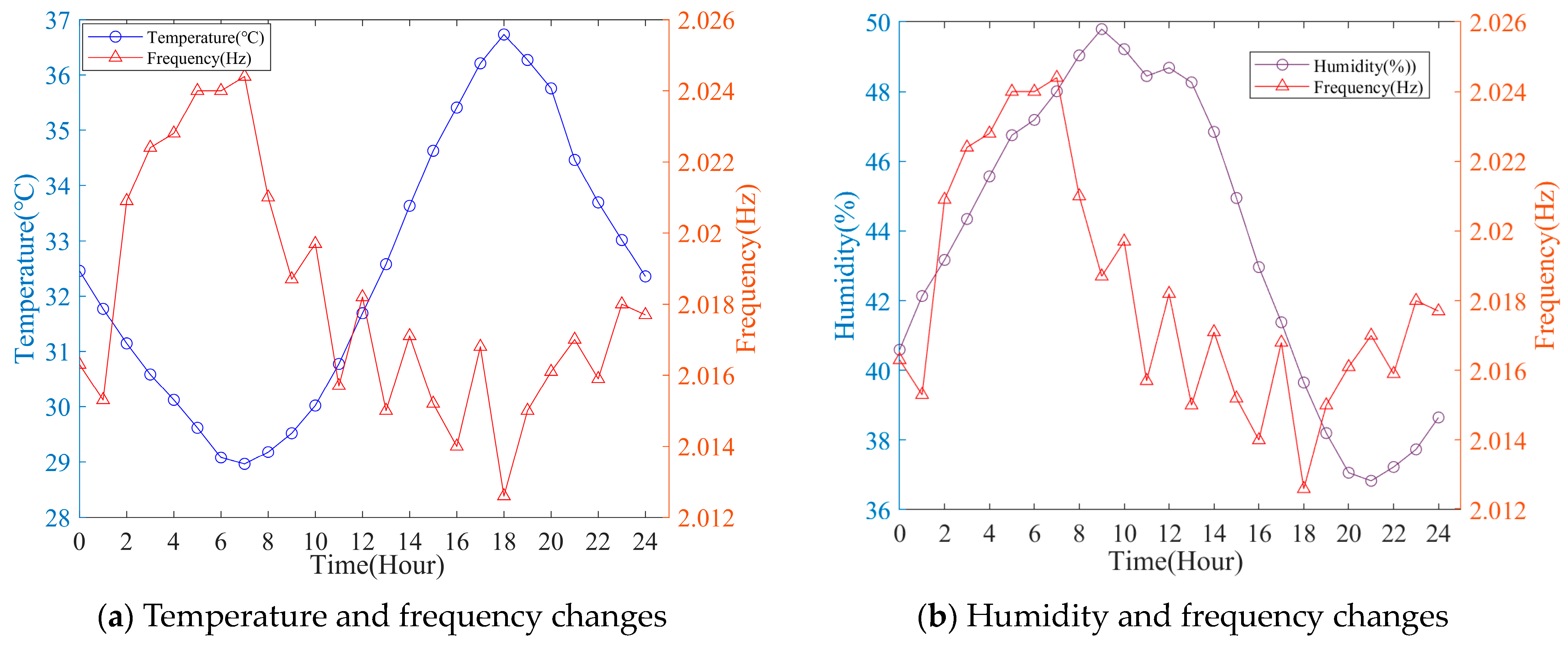
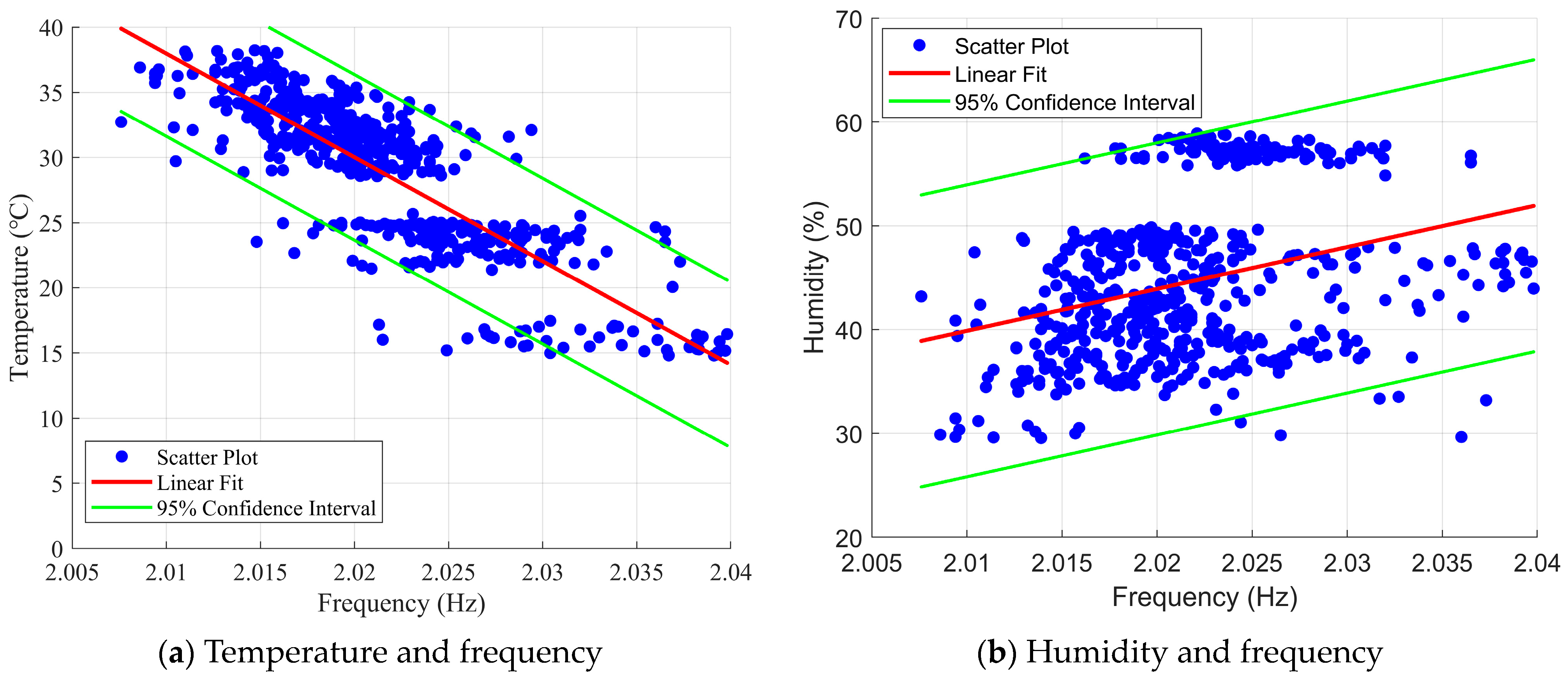
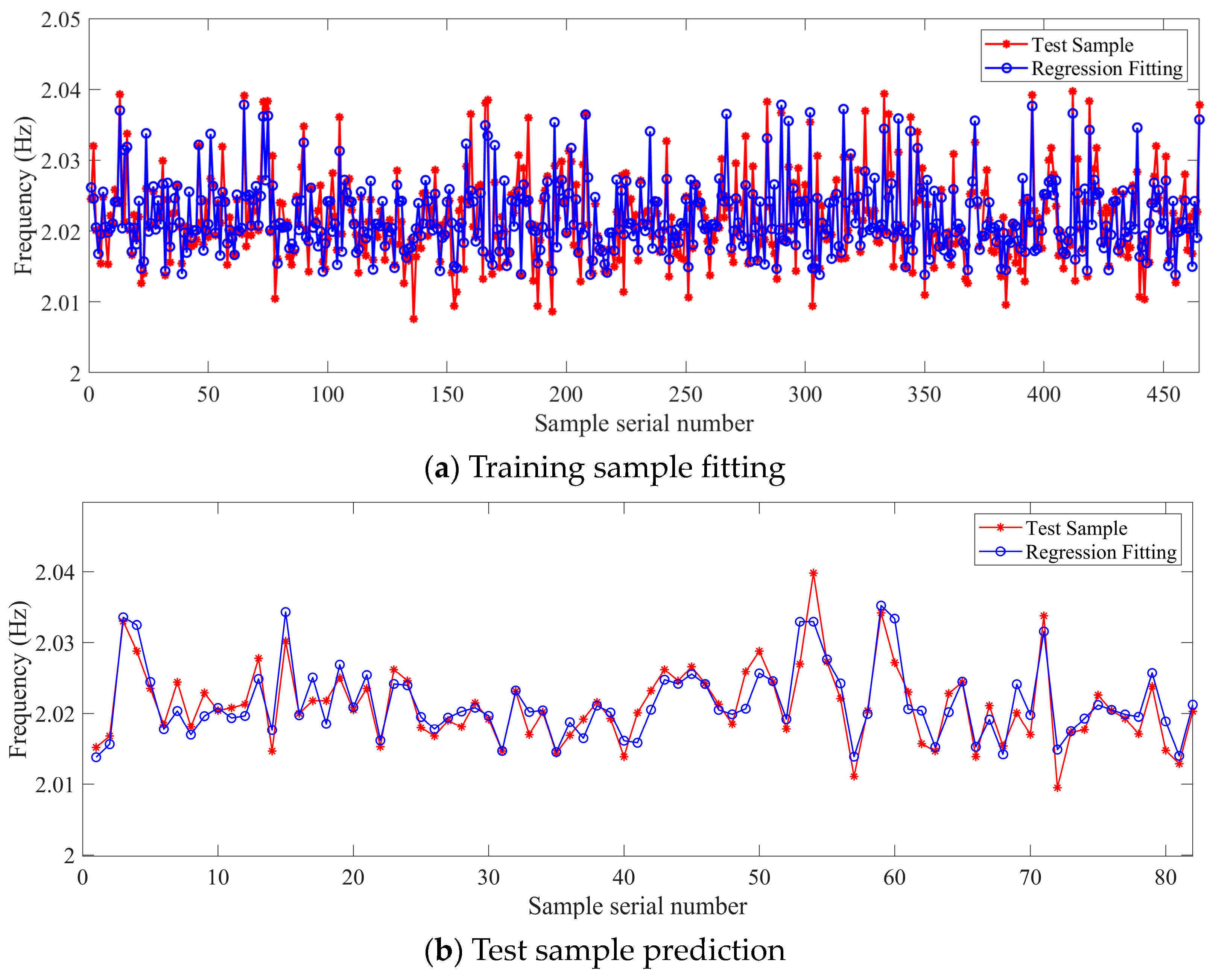
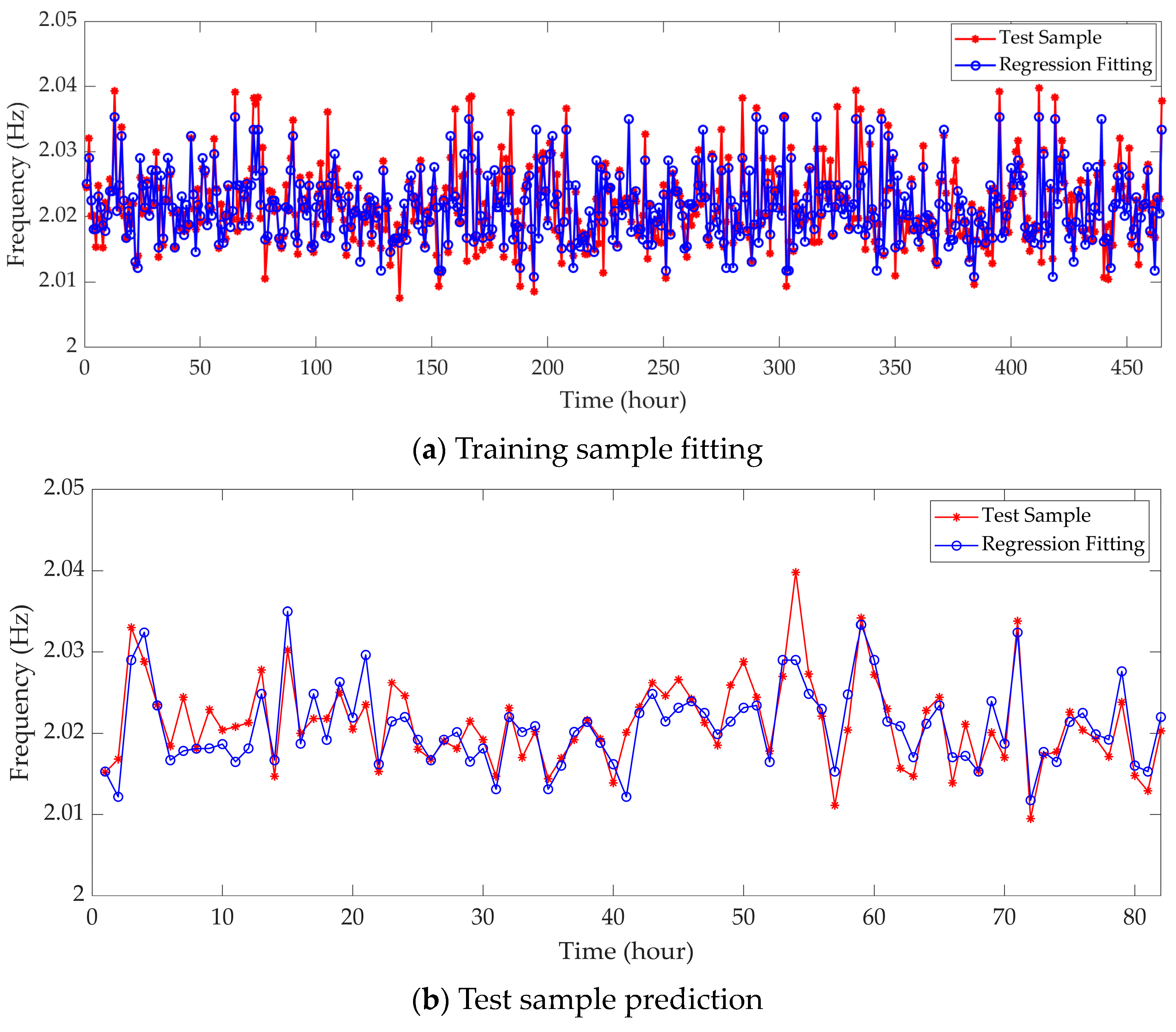

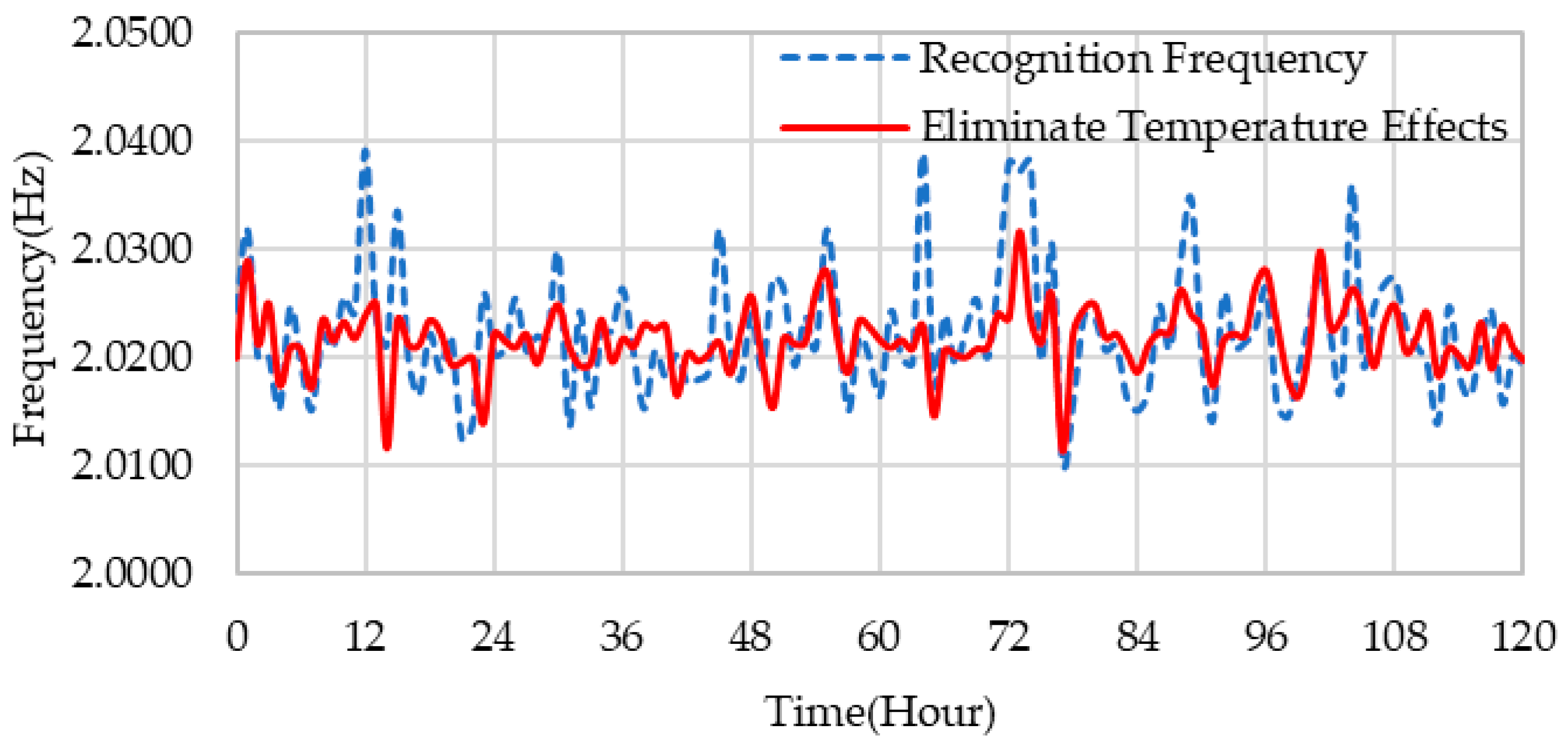
| Parameters | Numerical Value |
|---|---|
| standard range | 2 G |
| measurement precision | 2‰ F.S. |
| resolution | 0.1‰ F.S. |
| measurement frequency | 10 HZ |
| natural frequency | >2 kHZ |
| sampling frequency | 50 HZ |
| Parameters | Numerical value | |
|---|---|---|
| standard range | humidity | 0~100% RH |
| temperature | −20~+80 °C | |
| measurement precision | humidity | ±3% RH (11~89% RH, 25 °C) |
| temperature | ±0.5 °C (25 °C) | |
| sampling frequency | ≥0.02 Hz | |
| Identified Frequencies (Hz) | Computation Time (s) | |||||||||||
|---|---|---|---|---|---|---|---|---|---|---|---|---|
| No. Mode | 1 | 2 | 3 | 4 | 5 | 6 | 7 | 8 | 9 | 10 | ||
| Finite Element | 0.293 | 0.879 | 1.367 | 1.601 | 1.758 | 2.014 | \ | \ | \ | \ | \ | |
| Automated SSI-COV | i = 20 | 0.298 | 0.841 | 1.350 | 1.599 | 1.722 | 2.026 | \ | \ | \ | \ | 36.40 |
| i = 40 | 0.298 | 0.640 | 0.841 | 0.990 | 1.166 | 1.262 | 1.350 | 1.599 | 1.722 | 1.762 | 39.53 | |
| i = 80 | 0.298 | 0.372 | 0.640 | 0.685 | 0.842 | 0.853 | 0.990 | 1.166 | 1.262 | 1.350 | 43.28 | |
| Parameters/No. Mode | Mean Value/Hz | Maximum Value/Hz | Minimum Value/Hz | Relative Difference/% |
|---|---|---|---|---|
| 1 | 0.2977 | 0.3061 | 0.2940 | 4.2 |
| 2 | 0.8412 | 0.8585 | 0.8312 | 3.28 |
| 3 | 1.3480 | 1.3691 | 1.3303 | 2.92 |
| 4 | 1.5959 | 1.6100 | 1.5871 | 1.44 |
| 5 | 1.7602 | 1.7699 | 1.7501 | 1.13 |
| 6 | 2.0217 | 2.0398 | 2.0076 | 1.6 |
| Parameters | Numerical Value |
|---|---|
| C | 20 |
| gamma | 2 |
| epsilon | 0.01 |
| tol | 0.001 |
| Model | Error Type | Identification Frequency (Hz) | |
|---|---|---|---|
| Support vector machine regression | Fitting | Root mean square error (RMSE) | 0.0082823 |
| Coefficient of determination (R2) | 0.82141 | ||
| Kurtosis | 4.4081 | ||
| Skewness | −0.13324 | ||
| Prediction | Root mean square error (RMSE) | 0.0024545 | |
| Coefficient of determination (R2) | 0.89251 | ||
| Kurtosis | 3.3516 | ||
| Skewness | 0.054079 | ||
| Random forests | Fitting | Root mean square error (RMSE) | 0.0035515 |
| Coefficient of determination (R2) | 0.8158 | ||
| Prediction | Root mean square error (RMSE) | 0.0035456 | |
| Coefficient of determination (R2) | 0.78096 | ||
Disclaimer/Publisher’s Note: The statements, opinions and data contained in all publications are solely those of the individual author(s) and contributor(s) and not of MDPI and/or the editor(s). MDPI and/or the editor(s) disclaim responsibility for any injury to people or property resulting from any ideas, methods, instructions or products referred to in the content. |
© 2023 by the authors. Licensee MDPI, Basel, Switzerland. This article is an open access article distributed under the terms and conditions of the Creative Commons Attribution (CC BY) license (https://creativecommons.org/licenses/by/4.0/).
Share and Cite
Xu, J.; Xiao, T.; Liu, Y.; Hong, Y.; Pu, Q.; Wen, X. Correlation Analysis of Large-Span Cable-Stayed Bridge Structural Frequencies with Environmental Factors Based on Support Vector Regression. Sensors 2023, 23, 9442. https://doi.org/10.3390/s23239442
Xu J, Xiao T, Liu Y, Hong Y, Pu Q, Wen X. Correlation Analysis of Large-Span Cable-Stayed Bridge Structural Frequencies with Environmental Factors Based on Support Vector Regression. Sensors. 2023; 23(23):9442. https://doi.org/10.3390/s23239442
Chicago/Turabian StyleXu, Jingye, Tugang Xiao, Yu Liu, Yu Hong, Qianhui Pu, and Xuguang Wen. 2023. "Correlation Analysis of Large-Span Cable-Stayed Bridge Structural Frequencies with Environmental Factors Based on Support Vector Regression" Sensors 23, no. 23: 9442. https://doi.org/10.3390/s23239442
APA StyleXu, J., Xiao, T., Liu, Y., Hong, Y., Pu, Q., & Wen, X. (2023). Correlation Analysis of Large-Span Cable-Stayed Bridge Structural Frequencies with Environmental Factors Based on Support Vector Regression. Sensors, 23(23), 9442. https://doi.org/10.3390/s23239442






